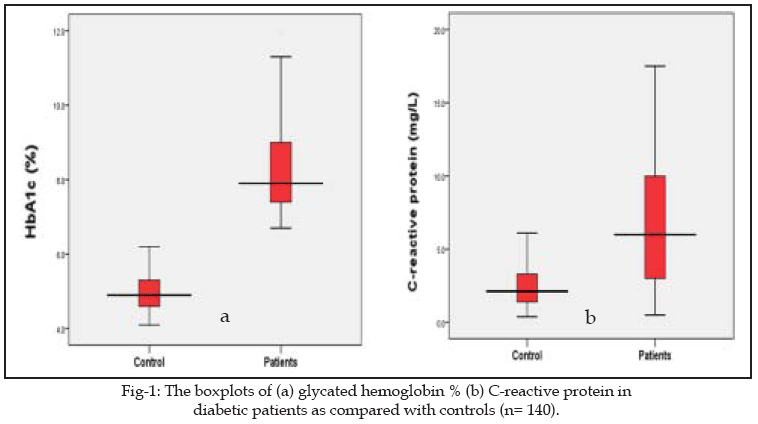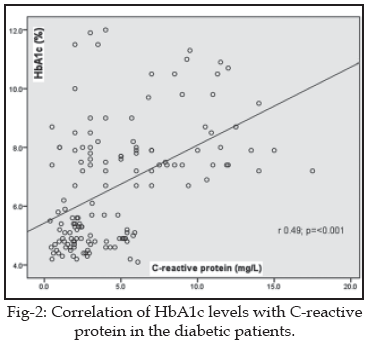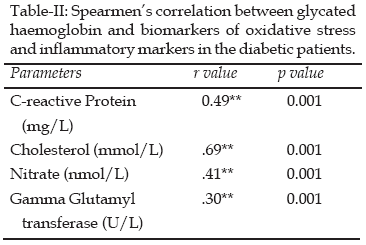1. Shen R, Wiegers SE, Glaser R. The evaluation of cardiac
and peripheral arterial disease in patients with diabetes; mellitus. Endocr
Res 2007;32(3):109-42.
2. Wu JT, Wu LL. Linking inflammation and atherogenesis:
Soluble markers identified for the detection of risk factors and for early
risk assessment. Clin Chim Acta 2006;366(1-2):74-80.
3. Vitale C , Fini M, Leonardo F, Rossini P, Cerquetani
E, Onorati D, et al . "Effect of estradiol valerate alone or in association
with cyproterone acetate upon vascular function of postmenopausal women at
increased risk for cardiovascular disease, Maturitas. 2001;40(3):239–45.
4. Farah R, Shurtz-Swirski R, Lapin O. Intensification of
oxidative stress and inflammation in type II diabetes despite
antihyperglycemic treatment. Cardiovasc Diabetol 2008;7(20):1-8.
5. de Rekeneire N, Peila R, Ding J, Colbert LH, Visser M,
Shorr RI, et al. Diabetes, hyperglycemia, and inflammation in older
individuals: the health, aging and body composition study. Diabetes Care
2006;29(8):1902-08.
6. Leitinger N. Oxidized phospholipids as modulators of
inflammation in atherosclerosis. Curr Opin Lipidol 2003;14(5):421-30.
7. Petitti DB, Imperatore G, Palla SL, Daniels SR, Dolan
LM, Kershnar AK. et al. Serum lipids and glucose control: the search for
diabetes in youth study. Arch Pediatr Adolesc Med 2007;161 (2): 159 – 65.
8. Abdel-Gayoum AG. The effect of glycemic control in type
II diabetic patients with diabetes-related dyslipidemia. Saudi Med J
2004;25(2):207-11.
9. Meisinger C, Lowel H, Heier M, Schneider A, Thorand B.
KORA Study Group. Serum gamma-glutamyltransferase and risk of type 2 diabetes
mellitus in men and women from the general population. J Intern Med.
2005;258(6):527-35
10. Dehghan A, van Hoek M, Sijbrands EJ, Stijnen T, Hofman
A, Witteman JC. Risk of type 2 diabetes attributable to C-reactive protein and
other risk factors. Diabetes Care 2007;30(10):2695-99
11. Esper RJ, Vilariño JO, Machado RA, Paragano A.
Endothelial dysfunction in normal and abnormal glucose metabolism. Adv Cardiol
2008;45:17-43.
12. Simão AN, Dichi JB, Barbosa DS, Cecchini R, Dichi I .
Influence of uric acid and gamma-glutamyltransferase on total antioxidant
capacity and oxidative stress in patients with metabolic syndrome.
Nutrition 2008;24(7-8):675-81.
13. Sedda V, Chaira BD, Parolini M, Caruso R, Campolo J,
Cighetti G, et al. Plasma glutathione level are independently associated with
Gamma Glutamyl transferase activity in subjects with cardiovascular risk
factors. Free Rad Res 2008;42(2):135-41.
14. Pacher P, Beckman JS, Liaudet L. Nitric oxide and
peroxynitrite in health and disease. Physiol Rev 2007;87(1):315-424.
15. Roberts WL, Sedrick R, Moulton L, Spencer A, Rifai N.
Evaluation of four automated high-sensitivity C-reactive protein methods:
implications for clinical and epidemiological applications. Clin Chem
2000;46(4):461-8.
16. Schumann G, Bonora R, Ceriotti F, Clerc-Renaud, P,
Ferard G, Ferrero CA. et al. IFCC primary reference procedures for the
measurement of catalytic activity concentrations of enzymes at 37o C. Part 6,
Reference procedure for the measurement of catalytic concentration of gamma
glutamyltransferase. Clin Chem Lab Med 2002;40(7):734-8.
17. Giovannoni G, Land JM, Keir G, Thompsion EJ, Heales SJR.
Adaption of nitric reductase and Griess reaction methods for measurement of
serum nitrate plus nitrite levels. Ann Clin Biochem 1997; 34:193-8
18. Goldstein DE, Little RR, Wiedmeyer HM, England JD,
Rohlfing CG. Glycated haemoglobin estimation in the 1990’s: A review of assay
methods and clinical interpretation. In: Marshall SM, Home PD, editor. The
Diabetes Annual. New York (NY): Elsevier Science B.V; 1994;p.193–212.
19. Ellerbe P, Myers GL, Cooper GR, Hert HS, Sniegoski LT,
Welch MJ, et al. A comparison of results for cholesterol in human serum by the
reference method and by the definitive method of the National Reference System
for cholesterol. Clin Chem 1990; 36(2): 370-5.
20. Selvin E, Marinopoulos S, Berkenblit G, Rami T,
Brancati FL, Powe NR, et al. Meta-analysis: glycosylated hemoglobin and
cardiovascular disease in diabetes mellitus. Ann Intern Med
2004;141(6):421-31.
21. Middelbeek RJ, Horton ES. The role of glucose as an
independent cardiovascular risk factor. Curr Diab Rep 2007;7(1):43-9.
22. Schulze MB. Rimm EB, Li T, Rifai N, Stampfer MJ, Hu FB.
C-reactive protein and incident cardiovascular events among men with diabetes.
Diabetes Care. 2004;27(4):889–94.
23. Pereira FO, Frode TS, Medeiros YS. Evaluation of tumour
necrosis factor alpha, interleukin-2 soluble receptor, nitric oxide
metabolites, and lipids as inflammatory markers in type II diabetes mellitus.
Mediators Inflamm 2006;1:1-7
24. Pfutzner A, Forst T. High-sensitivity C - reactive
protein as Cardiovascular risk marker in patients with diabetes mellitus.
Diabetes Technol Ther 2006;8(1):28-36.
25. Ridker PM. C-reactive protein: eighty years from
discovery to emergence as a major risk marker for cardiovascular disease. Clin
Chem 2009; 55(2): 209–215.
26. Marsik C, Kazemi-Shirazi L, Schickbauer T, Winkler S,
Wagner OF, Endler G. C-reactive protein and all-cause mortality in a large
hospital-based cohort. Clin Chem 2008;54(2):234-7.
27. Izumi N, Nagaoka T, Mori F, Sato E, Takahashi A,
Yoshida A. Relation between plasma nitric oxide levels and diabetic
retinopathy. Jpn J Ophthalmol 2006;50(5):465-8
28. Ramakrishna V, Jailkhani R. Oxidative stress in
non-insulin-dependent diabetes mellitus (NIDDM) patients. Acta Diabetol
2008;45(1):41-6.
29. Bauersachs J, Schaefer A. Tetrahydrobiopterin and eNOS
dimer/monomer ratio: a clue to eNOS uncoupling in diabetes? Cardiovasc Res
2005;65(4):823-31.
30. Guzik TJ, Mussa S, Gastaldi D, Sadowski J, Ratnatunga
C, Pillai R, et al. Mechanisms of increased vascular superoxide production in
human diabetes mellitus: role of NAD(P)H oxidase and endothelial nitric oxide
synthase. Circulation 2002;105:1656–62.
31. Verma S, Wang CH, Li SH, Dumont AS, Fedak PW, Badiwala
MV, et al. A self-fulfilling prophecy: C-reactive protein attenuates nitric
oxide production and inhibits angiogenesis. Circulation 2002; 106(8):913-9.
32. Lee MY, Koh SB, Koh JH, Nam SM, Shin JY, Shin YG. et
al. Relationship between gamma-glutamyltransferase and metabolic syndrome in a
Korean population. Diabet Med 2008;25(4):469-75.
33. Lee DS, Evans JC, Robins SJ, Wilson PW, Albano I, Fox
CS. et al. Gamma glutamyl transferase and metabolic syndrome, cardiovascular
disease, and mortality risk: The Framingham Heart Study. Arterioscler Thromb
Vasc Biol 2007;27(1):127–33.




